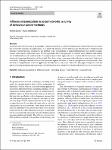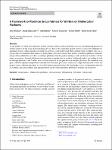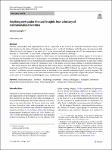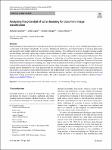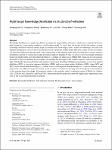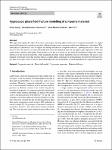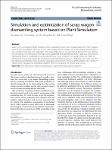Search
Author
- Osman, Ahmed I. (5)
- Daqing, Ma (3)
- Jorgensen, Ed (3)
- Li, Yan (3)
- next >
Subject
- kinh tế (26)
- Economics (12)
- programming (10)
- XRD (10)
- next >
Date issued
- 2020 - 2025 (2128)
- 2010 - 2019 (129)
- 2000 - 2009 (9)
- 1999 - 1999 (1)
Has File(s)
Search Results
Social networks have become an increasingly common abstraction to capture the interactions of individual users in a number of everyday activities and applications. As a result, the analysis of such networks has attracted lots of attention in the literature. Among the topics of interest, a key problem relates to identifying so-called influential users for a number of applications, which need to spread messages. Several approaches have been proposed to estimate users’ influence and identify sets of influential users in social networks. A common basis of these approaches is to consider links between users, that is, structural or topological properties of the network. To a lesser extent, some approaches take into account users’ behaviours or attitudes. |
As the number of online labor platforms and the diversity of jobs on these platforms increase, ensuring group fairness for workers needs to be the focus of job-matching services. Risk of discrimination against workers occurs in two different job-matching services: when someone is looking for a job (i.e., a job seeker) and when someone wants to deploy jobs (i.e., a job provider). To maximize their chances of getting hired, job seekers submit their profiles on different platforms. Similarly, job providers publish their job offers on multiple platforms with the goal of reaching a wide and diverse workforce. In this paper, we propose a theoretical framework to maximize group fairness for workers 1) when job seekers are looking for jobs on multiple platforms, and 2) when jobs are being d... |
Scholars, policymakers and organizations in the EU, especially at the level of the European Commission, have turned their attention to the ethics of (trustworthy and human-centric) Artificial Intelligence (AI). However, there has been little reflexivity on (1) the history of the ethics of AI as an institutionalized phenomenon and (2) the comparison to similar episodes of “ethification” in other fields, to highlight common (unresolved) challenges. |
Deep learning has been extensively researched in the field of document analysis and has shown excellent performance across a wide range of document-related tasks. As a result, a great deal of emphasis is now being placed on its practical deployment and integration into modern industrial document processing pipelines. It is well known, however, that deep learning models are data-hungry and often require huge volumes of annotated data in order to achieve competitive performances. And since data annotation is a costly and labor-intensive process, it remains one of the major hurdles to their practical deployment. This study investigates the possibility of using active learning to reduce the costs of data annotation in the context of document image classification, which is one of the cor... |
Knowledge distillation is a simple yet effective technique for deep model compression, which aims to transfer the knowledge learned by a large teacher model to a small student model. To mimic how the teacher teaches the student, existing knowledge distillation methods mainly adapt an unidirectional knowledge transfer, where the knowledge extracted from different intermedicate layers of the teacher model is used to guide the student model. However, it turns out that the students can learn more effectively through multi-stage learning with a self-reflection in the real-world education scenario, which is nevertheless ignored by current knowledge distillation methods. Inspired by this, we devise a new knowledge distillation framework entitled multi-target knowledge distillation via stud... |
This paper investigates the effect of moisture content upon the degradation behaviour of composite materials. A coupled phase field framework considering moisture diffusion, hygroscopic expansion, and fracture behaviour is developed. This multi-physics framework is used to explore the damage evolution of composite materials, spanning the micro-, meso- and macro-scales. The micro-scale unit-cell model shows how the mismatch between the hygroscopic expansion of fibre and matrix leads to interface debonding. From the meso-scale ply-level model, we learn that the distribution of fibres has a minor influence on the material properties, while increasing moisture content facilitates interface debonding. The macro-scale laminate-level model shows that moisture induces a higher degree of dam... |
Bayesian approaches to legal reasoning propose causal models of the relation between evidence, the credibility of evidence, and ultimate hypotheses, or verdicts. They assume that legal reasoning is the process whereby one infers the posterior probability of a verdict based on observed evidence, or facts. In practice, legal reasoning does not operate quite that way. Legal reasoning is also an attempt at inferring applicable rules derived from legal precedents or statutes based on the facts at hand. To make such an inference, legal reasoning follows syllogistic logic and first order transitivity. |
Based on the existing plant layout and process flow, a simulation analysis was conducted using the Plant Simulation platform with the utilization efficiency of each station and production capacity of the dismantling system as indicators. A problem with long-term suspension in the disassembly process was determined. Based on the two optimization directions of increasing material transportation equipment and expanding the buffer capacity, a cost-oriented optimization model is established. A genetic algorithm and model simulation were used to solve the model. An optimization scheme that satisfies the production needs and has the lowest cost is proposed. The results show that the optimized dismantling system solves the suspended work problem at the dismantling station and a significant ... |
Parametric timed automata (PTA) have been introduced by Alur, Henzinger, and Vardi as an extension of timed automata in which clocks can be compared against parameters. The reachability problem asks for the existence of an assignment of the parameters to the non-negative integers such that reachability holds in the underlying timed automaton. The reachability problem for PTA is long known to be undecidable, already over three parametric clocks. A few years ago, Bundala and Ouaknine proved that for PTA over two parametric clocks and one parameter the reachability problem is decidable and also showed a lower bound for the complexity class PSPACENEXP. |
Simulation platforms facilitate the development of emerging Cyber-Physical Systems (CPS) like self-driving cars (SDC) because they are more efficient and less dangerous than field operational test cases. Despite this, thoroughly testing SDCs in simulated environments remains challenging because SDCs must be tested in a sheer amount of long-running test cases. Past results on software testing optimization have shown that not all the test cases contribute equally to establishing confidence in test subjects’ quality and reliability, and the execution of “safe and uninformative” test cases can be skipped to reduce testing effort. However, this problem is only partially addressed in the context of SDC simulation platforms. In this paper, we investigate test selection strategies to increa... |

